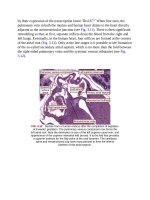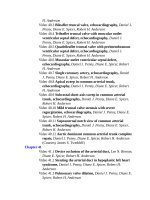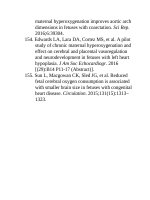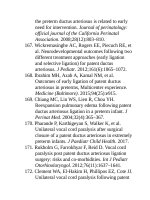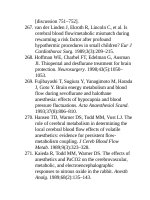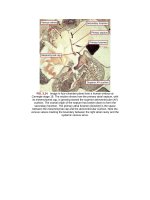Andersons pediatric cardiology 156
Bạn đang xem bản rút gọn của tài liệu. Xem và tải ngay bản đầy đủ của tài liệu tại đây (125.23 KB, 3 trang )
PhysiologyoftheDevelopingHeart
HelenaM.Gardiner
Keywords
Fetal;Cardiovascular;physiology
Introduction
Theheartisthefirstorgantobecomefullyfunctionalinthedevelopingembryo,
providingthecirculatorysystemnecessaryforembryogenesisandsubsequent
fetaldevelopmentwhengrowthcannotbesustainedbydiffusionofnutrients.
Rapidadvancesingeneticsandmolecularbiologyhaverevolutionizedour
knowledgeofthedevelopingembryonicheart.Furthermore,technical
improvementsinimagingandnoninvasivephysiologicrecordingoftheearly
humanfetushaveenabledustobuildoninformationfromstudiesofanimal
models.1Improvedtechnologyhasalsoprovidednewinsightsintohuman
cardiovasculardevelopmentindiseasestates,andfetalresponsestointrauterine
challengescanbemeasurednoninvasively.Thischapterreviewscurrent
understandingofthephysiologyandpathophysiologyofthefetalcardiovascular
systemanddiscussescurrentevidenceforthelonger-termimpactoffetal
adaptationsonsubsequentdevelopmentinchildhoodandbeyond.
EmbryonicCirculation
Inthechickembryo,rhythmicpulsationsofapproximately50Hzbegininthe
ventricle,coincidentwithfusionofcushionsintheventriculoarterialsegment.
Thesepulsationsareinsufficientlyforcefultosetbloodinmotionortogenerate
recordablepressures.2Thisisbecausetheorganizationofintracellularcontractile
proteinsisincompleteatthisstage,thefunctionalcontractileunitsarenotfully
assembled,andthematrixofcollagenhasnotyetformed.3Oncecardiacrhythm
isestablished,themyofibrilswithinthemyocytesbecomealignedand,asthe
heartraterises,thedirectionofflowofbloodisestablishedtoprovidea
circulationforthegrowingembryo.Growthoftheatriumsandventriclesis
associatedwithanincreaseintherateofpulsationoftheprimitivehearttube.
Thisestablishesthedirectionofpropagationoftheperistalticwavesof
contractionfromatriumtoventricle.
Cardiacmyocytesisolatedfromthevenoussinus,atrium,andventricleatthis
developmentalstageinthechickembryoallexhibitautomaticitywithdifferent
intrinsicratesofcontraction.Theventricleisslowest,atapproximately50to60
Hz,whereascellsfromthevenoussinushavethefastestrate,withtheatrium
beingintermediate.Theearliestrecordingsofhumanfetalcardiacactivitywere
obtainedusinghigh-frequencytransvaginalultrasoundat25daysafter
fertilization.Themeanheartrateatthisstageofgestationisapproximately90
beatsperminutesandregular.Thismostlikelyrepresentsatrialrhythm.The
mechanismresponsibleforthecharacteristicearlyincreaseinheartratebetween
thefifthandeighthweeksofgestationisuncertainbutiscomparabletothat
occurringinthechickembryo.Inchicks,itisassociatedwiththetransitionof
thepacemaker,firstfromventricletoatriumasfusionoccursbetweenthetwo,
andthentothevenoussinusasthissegmentbecomesincorporatedintotheright
atrium.Theprecursorofthesinusnode,whichassumestheroleofthecardiac
pacemakersubsequently,formsatthejunctionofthedevelopingsuperiorcaval
veinwiththeatrium.
By8to10weeks,themeanheartrateinthehumanfetusvariesbetween160
and170beats/min,decliningtoanaverageof150beats/minat15weeks.After
this,theratedeclinesprogressivelytowardterm(Fig.6.1).4Thispatternof
changeinheartrate,seenduringembryonicandfetallifeinthehuman,also
parallelsthatoccurringinthechick,inwhichcardiacactionbeginsbetween33
